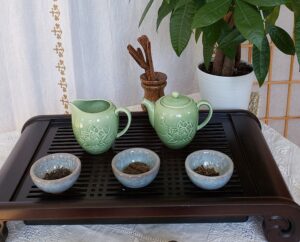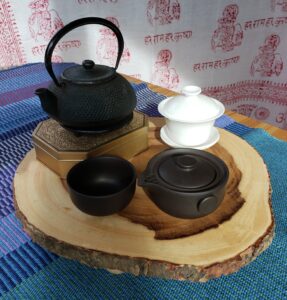 Ahhh, teapots…
Ahhh, teapots…
As you can imagine, I have quite a few teapots. Some are reserved for specific teas, others are purely utilitarian. I have several traditional English style teapots but I almost never use them because I’m most often brewing tea for one or two people and I also brew Chinese style rather than European style tea.
So, here are some my personal perspectives with regard to the pro’s and con’s of Chinese/Japanese style teapots…
Yixing teapots – should be reserved for a single variety of tea. My favorite I only use for Wuyi Rock Oolong teas. If I were a complete purist, it would only be used for an individual varietal within that family, but… The pot should be kept damp so that the clay never completely dries out. They can develop cracks if they dry out too much. I solved this by storing mine above my water boiler which vents steam onto the pot… They can be absolutely beautiful, come in many designs, and can vary in price from $25 and up into the thousands.
Glass, ceramic, cast iron teapots – all are great multi-use teapots. You can thoroughly wash them between uses and don’t need to be concerned that the teas will “cross-pollinate” with a small exception. If the tea sits in a metal basket, you’ll need to make sure that the basket periodically gets thoroughly cleansed so that it doesn’t hold the essence of previous teas.
Gaiwans – I like the gaiwan design and ease of use. Gaiwans come in glass, ceramic and Yixing clay. Consider how you want to use the pot when selecting the material. Some of the modern versions are easier to use without burning your fingers. My favorite pot for years was a thick ceramic Gaiwan, that unfortunately didn’t bounce on concrete… Now I have both ceramic and Yixing Gaiwans. As with all tea brewing, be sure to fully decant the tea after brewing.
Press pots – I prefer to use a press pot for herbals or coffee and not for tea – you can never fully decant the tea from a press pot and so it’s not useful with good quality tea.
Glass pots – pretty but mostly too fragile for me. I inevitably break them in the sink or drop them or ding and chip them…however, there’s one that you can get at the Oriental Grocery in Decatur (across the tracks from DHA) that has a straight sided glass pot with an innovative design for the brewing basket and its dispensing mechanism. I’ve had 3 or 4 of them (I’m hard on glass…) over the years and because they’re so functional and easy to clean, I keep replacing it. I think it cost $10 the last time I purchased one.
Spouts – I don’t like long spouts on my teapots because I tend to break them off. I tend to like more compact, squat teapots. They keep the heat better. In the fancy Gong Fu Tea ceremonies they use long-spouted pots because it’s showier and you can pour the tea from a great height with more precision – but that’s for show… In truth the tea gets cold faster which is an issue if you’re living without heat…
 Here are my current favorite pots:
Here are my current favorite pots:
- An Yixing Gaiwan with cup that I reserve for Fujian Wuyi Rock Oolong teas.
- A simple white traditional ceramic Gaiwan that I use for Pu-Erh and other teas that I want to brew in small quantities.
- Last but not least is a cast iron teapot that holds a little more than one cup of tea. I use it for brewing Assam black teas, Lapsang Shouchong and other Chinese black and green teas.
I wish you great fun as you explore the world of tea and the wide world of tea pots!